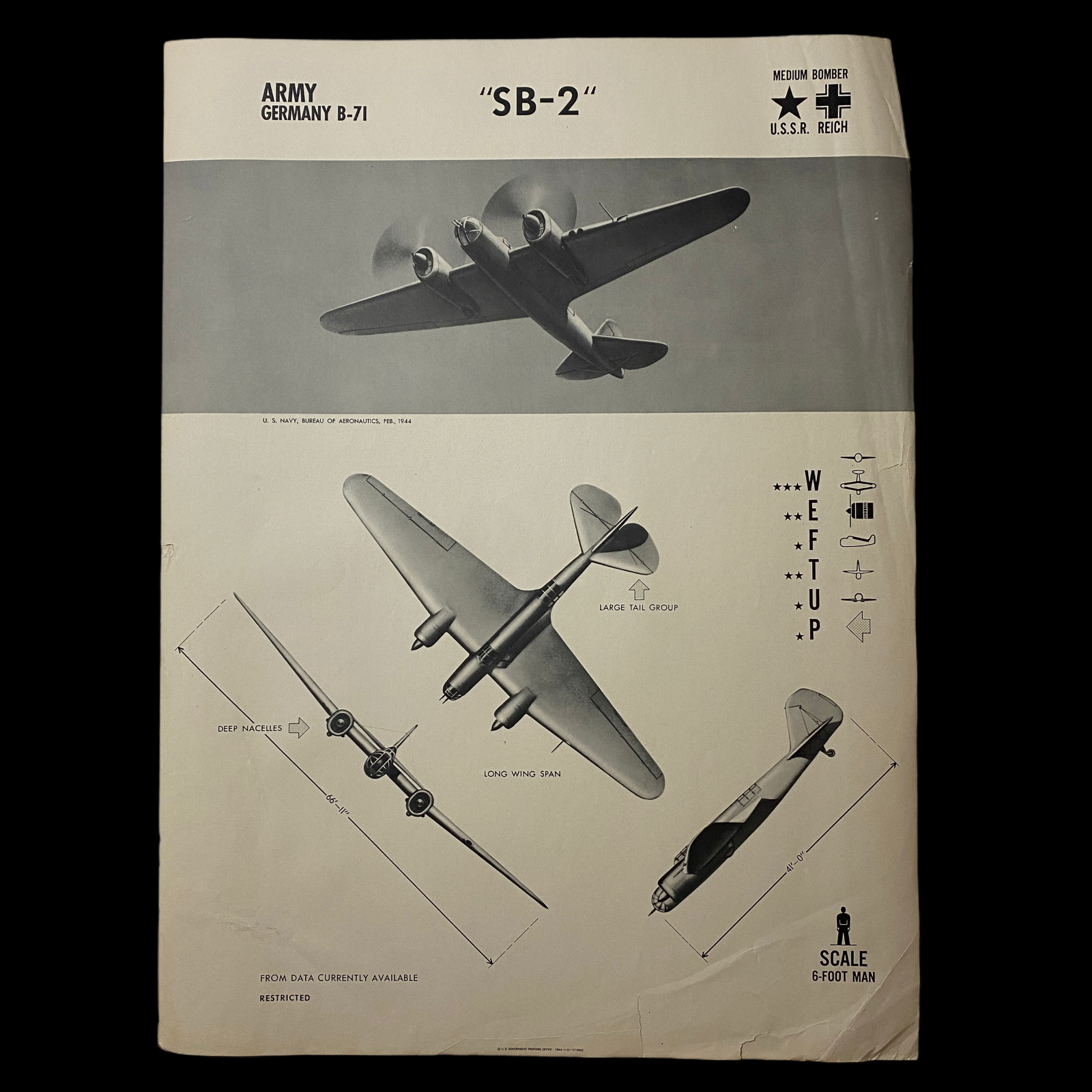
WWII 1944 German Soviet USSR Medium Bomber \"Tupolev SB\" W.E.F.T.U.P. ID Poster For Sale

When you click on links to various merchants on this site and make a purchase, this can result in this site earning a commission. Affiliate programs and affiliations include, but are not limited to, the eBay Partner Network.
WWII 1944 German Soviet USSR Medium Bomber \"Tupolev SB\" W.E.F.T.U.P. ID Poster:
$212.50
Size: 19 x 25 inches
This original ‘RESTRICTED’ aircraft identification poster was published by the U.S. Naval Aviation Training Division Feb 1944. This poster was posted as a training tool as well as an in theater ID poster to help U.S. and other Allied pilots, bomber crews and Naval personal to identify Allied and enemy aircraft. W.E.F.T.U.P. or Wing, Engine, Fuselage, Tail, Undercarriage, Peculiarities was a system set up for the purpose of aircraft identification and recognition.
World War II saw some of the first introduction of these aircraft ID poster to prevent friendly fire and more accurate plane recognition in combat. It was believed these posters alone could save countless lives from friendly aircraft-on-aircraft or friendly anit-aircraft fire. These posters also could cut down precious second pilots, bomber gunners, and naval gun crews would have to ID a plane flying towards them intern saving their lives by shooting first.
Each poster provides the silhouettes, dimensions, and relevant information to educate both air and ground personnel in aircraft identification. Immediate identification of aircraft, friendly or not, was essential in order for the observer (whether in the air e.g., pilot, gunner, or patrol observer, or on the ground, e.g., anti-aircraft crew) to determine his next course of action (e.g., acknowledge, attack, evade, or report). Each poster details a large clean sky and background image of the specified aircraft located as the main top imagine on the poster. It also contains important ‘peculiarities’ such as where certain gun emplacements are located, other special aircraft features, as well as wing and length measurements.
TheTupolev ANT-40, also known by its service nameTupolev SB(Russian:Скоростной Bombardirovschik– high speed bomber) and development co-nameTsAGI-40, was a high first flown in1934. TheTupolevdesign was advanced but lacked refinement, much to the dismay of crews, maintenance personnel, andStalin, who pointed out that\"there are no trivialities in aviation\".Numerically the most important bomber in the world in the late 1930s, the SB was the first modernstressed skinaircraft produced in quantity in theSoviet Unionand probably the most formidable bomber of the mid-1930s. It was produced in the Soviet Union and was also built under license inCzechoslovakia. Many versions saw extensive action inSpain, theRepublic of China,Mongolia,Finlandand at the beginning ofWorld War IIagainstGermanyin 1941. It was also used in various duties in civil variants, astrainersand in many secondary roles. Successful in the Spanish Civil War because it outpaced mostfighters, the aircraft was obsolete by1941.[clarification needed]By June 1941, 94 percent of bombers in the Red Army air force (VVSRKKA) were SBs.WhenGermany invaded the Soviet Unionin June 1941, re-equipment with more modern aircraft such as thePe-2had begun. Still, 94% of the Soviet operational bomber force was equipped with SBs,[40]with 1,500–2,000 SBs deployed along the Western border districts of the Soviet Union.[41][42]TheLuftwaffestarted OperationBarbarossawith co-ordinated strikes against 66 major Soviet airfields,[41]destroying a large proportion of Soviet air strength on the ground or air on the first day of the invasion. The SBs that survived the carnage of the first day continued to be poorly used, many being frittered away in unescorted low-level attacks against German tanks, where the SB\'s relatively large size and lack of armour made it highly vulnerable to German lightFlak, while German fighters continued to take a heavy toll. Within a few days, losses forced most of the remaining SBs to switch to night attacks.[42]SBs continued to be used, in the defense ofLeningradandMoscow, mainly at night by attacking German artillery. By December 1941 almost all of the SBs had either been replaced or lost,[41]although it remained in large-scale use until March 1942 in the North against Finland.[42][43]SBs continued in use for non-combat roles such as supply dropping, glider towing and training, and continued in use in the Far East until 1945.

![]()
Titles of Distinction
- Hero of the Soviet Union
- Hero of Socialist Labor
- Pilot-Cosmonaut of USSR
- Dist. Military Pilot USSR
- Dist. Military Navigator USSR
- Dist. Test Pilot USSR
- Dist. Test Navigator USSR
- Distinguished Pilot USSR
- Dist. Navigator USSR
Orders of Distinction
- Order of Lenin
- Order of October Revolution
- Order of the Red Banner
- Order of Suvorov
- Order of Ushakov
- Order of Kutuzov
- Order of Nakhimov
- Order of Bogdan Khmelnitsky
- Order of Alexander Nevsky
- Order of the Patriotic War
- Order of Red Banner of Labor
- Order of Friendship
- Order of the Red Star
- Order Service to Motherland
- Order of the Badge of Honor
- Order of Honor
- Order of Personal Courage
- Order of Glory
- Order of Labor Glory
- Order of Mother Heroine
- Order of Maternal Glory